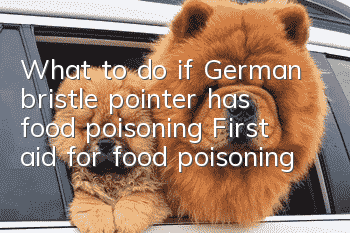What to do if German bristle pointer has food poisoning? First aid for food poisoning

What should I do if my German Wirehaired Pointer is poisoned by food? In daily life, dogs sometimes become poisoned by eating poisonous food. Therefore, all dog owners must learn some first aid methods for dog poisoning.
1. Causes of dog food poisoning
Dogs are most susceptible to food poisoning after eating spoiled food. In spoiled and rancid food, bacteria such as Proteus, Salmonella, Clostridium botulinum, and Staphylococcus aureus are often contaminated, resulting in obvious clinical symptoms.
For example, spoiled fish is contaminated by Proteus, which causes protein decomposition and the production of histamine. The incubation period of histamine poisoning is no more than 2 hours. The dog will suddenly vomit, have diarrhea, have a lot of nasal discharge, difficulty breathing, and dilated pupils. Economic disorders, etc. At this time, the dog may be comatose, with hindquarters paralysis, weak, urinating blood, and black feces.
Generally speaking, the earlier the symptoms appear, the more serious the poisoning is.
2. First aid for dog food poisoning
When a dog shows symptoms of poisoning, the owner of the dog does not need to panic and be nervous, but should calmly analyze the cause of the disease. Depending on the poisoned food and the length of time it was eaten, the following emergency measures can be taken:
1. Inducing and antivomiting:
Inducing vomiting is effective in a short period of time after eating food, and emetic drugs can be used. You can take 50 to 100 ml of 1% zinc sulfate solution. If necessary, use apomorphine (apomorphine) 3 mg subcutaneously. When spoiled food has been eaten for more than 4 hours and most of the food has entered the duodenum, emetic drugs cannot be used. Vomiting drugs should be used with caution in pregnant dogs. After vomiting, antiemetic drugs, such as diphenhydramine hydrochloride, can be used. The dog can be injected intramuscularly with 0.5~2 mg/kg body weight, and the oral dose is 2~5 mg/kg body weight, twice a day. Diphenamine 1~1.5 mg/kg body weight, intramuscular or subcutaneous injection.
2. Diarrhea and antidiarrhea:
Diarrhea is another method to promote the elimination of toxins from the gastrointestinal tract. If you have eaten toxic food for more than 2 to 3 hours and your mental state is still good, you can take laxatives to promote the elimination of toxic food as soon as possible. Be careful not to use vegetable oil when taking purgative measures. When the intestinal contents are basically exhausted, antidiarrheal drugs, such as atropine sulfate, can be used, 0.3 to 1 mg per time for dogs, kilogram of body weight, subcutaneous or intramuscular injection.
3. Antibacterial and anti-inflammatory:
In order to prevent the bacteria in the intestine from continuing to grow and reproduce and produce toxins, broad-spectrum antibiotics, such as gentamicin, chloramphenicol or tetracycline, should be taken orally.
4. Anti-shock:
In order to prevent shock in dogs, corticosteroids can be used, such as intramuscular injection of dexamethasone, 0.25~1 mg each time, or prednisone, prednisolone and other drugs.
If you feel better after the above treatment, you should pay attention to rest. Severe vomiting and diarrhea, temporary fasting, vomitingAfter stopping, give a liquid or semi-liquid diet, and let the sick dog drink more light salt water to supplement sufficient water. If there is no improvement or the poisoning symptoms are severe, you should be sent to the hospital for treatment in time.
3. Pay attention to the prevention of dog food poisoning
1. Feed the dog the food when it is cooked and eat it now. Do not leave it for a long time.
2. Discard fermented and spoiled food and never feed it again, because the toxins released by germs in food cannot be destroyed after heating and can still cause food poisoning or even death. For example, the toxin of Salmonella is heat-resistant and is still toxic after one hour at 75 degrees, which can cause food poisoning in animals.
- How to train a short-haired fox terrier to swim? How to train a short-haired fox terrier to swim?
- What to do about nephritis in Shorthaired Fox Terrier? Treatment of nephritis
- What should I do if my Scottish Deerhound loses hair? Introduction to the degree of hair loss
- How to bathe a Sippu puppy? How to bathe a Sippu puppy and what to pay attention to
- How to train a Sipaj Dog training tutorial
- How to clean the ears of a short-haired fox terrier How to clean ears
- How to train a Sipaj to pick up things? How to train a Sipaj to pick up things?
- How to toilet train a short-haired fox terrier? How to toilet train a short-haired fox terrier?
- How to treat anemia in Scottish Deerhounds? Treatment methods for anemia
- Why Shorthaired Fox Terrier Vomits? Introduction to the Causes of Shorthaired Fox Terrier Vomiting



